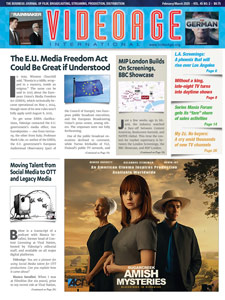Consider this: Up until recently, TV advertising rates kept going up and the number of spots increased despite drastic ratings drops. Today, the contrary is true: Advertising spots and rates are going down despite a surge in viewership.
The major U.S. TV networks are reportedly delaying their streaming Upfront presentations due to advertisers’ indecisiveness. However, in order for new series and renewals (in addition to straight-to-series orders) to go into production or pre-production in time for even a delayed new season start, the networks have to make their announcements by May or June. In addition to the $7 billion in primetime pre-ad sales that the Upfronts (which have been rescheduled, although the nets have yet to decide what form they will take) bring, the networks must also consider the $11 billion generated by their own studios with international sales driven by the new season. They must also keep in mind the fact that some of these sales are time-sensitive (as is the case with Canada).
Last week, both The New York Times and The Wall Street Journal published articles about local U.S. TV stations losing advertising revenue due to the COVID-19 pandemic, while still increasing viewership.
The Journal reported that local TV stations in the U.S. have more viewers than ever since viewers are leaning on local TV news for updates. For example, the WSJ article said, the Nexstar station group, which owns 196 local stations in 114 U.S. markets, has experienced ratings jumps of 35 percent since mid-March. However, the rise in viewership comes as companies and political campaigns pull back on ad spending.
Advertising, the WSJ pointed out, accounts for up to 46 percent of local TV revenue. Other income comes from retrans fees.
The Times piece focused on the advertising industry and its impact on business and society.
According to a report by the London, U.K.-based research firm IHS Markit, which was quoted in the article in the Times, each dollar that companies spent on advertising in the U.S. last year led to $9 in sales.
In the U.S., the ad industry employs about 500,000 people. In addition, the Times article said, according to the New York City-based ad trade group Interactive Advertising Bureau, overall spending on digital ads for March and April 2020 is down 38 percent from what companies had expected to lay out, and ad spending has fallen 41 percent on TV, 45 percent on radio, 43 percent in print publications, and 51 percent on billboards and other outdoor platforms.
This problem is compounded by the fact that many companies are trying to protect their brand names by keeping their ads away from media reports about overrun hospitals, joblessness, and death from coronavirus.
However, while many national TV advertising categories such as restaurants, travel/tourism, and retail have declined as expected due to COVID-19, other categories including automotive, insurance, and household products have been climbing. In this climate, some advertisers have shifted towards less expensive, non-premium inventory.
According to a recent report by the London-based research group Kantar, automotive advertising has seen a 13 percent increase in the number of 30-second commercials. Insurance has seen a 16 percent spike, and household products are seeing a 43 percent increase. Commercials for pharmaceuticals (over-the-counter and prescription drugs) posted a one percent hike.
On the flip side, travel/tourism is down 94 percent, food ads are 21 percent lower, retail is off 16 percent, restaurants are down seven percent, and financial services have registered a five percent drop.












Leave A Comment